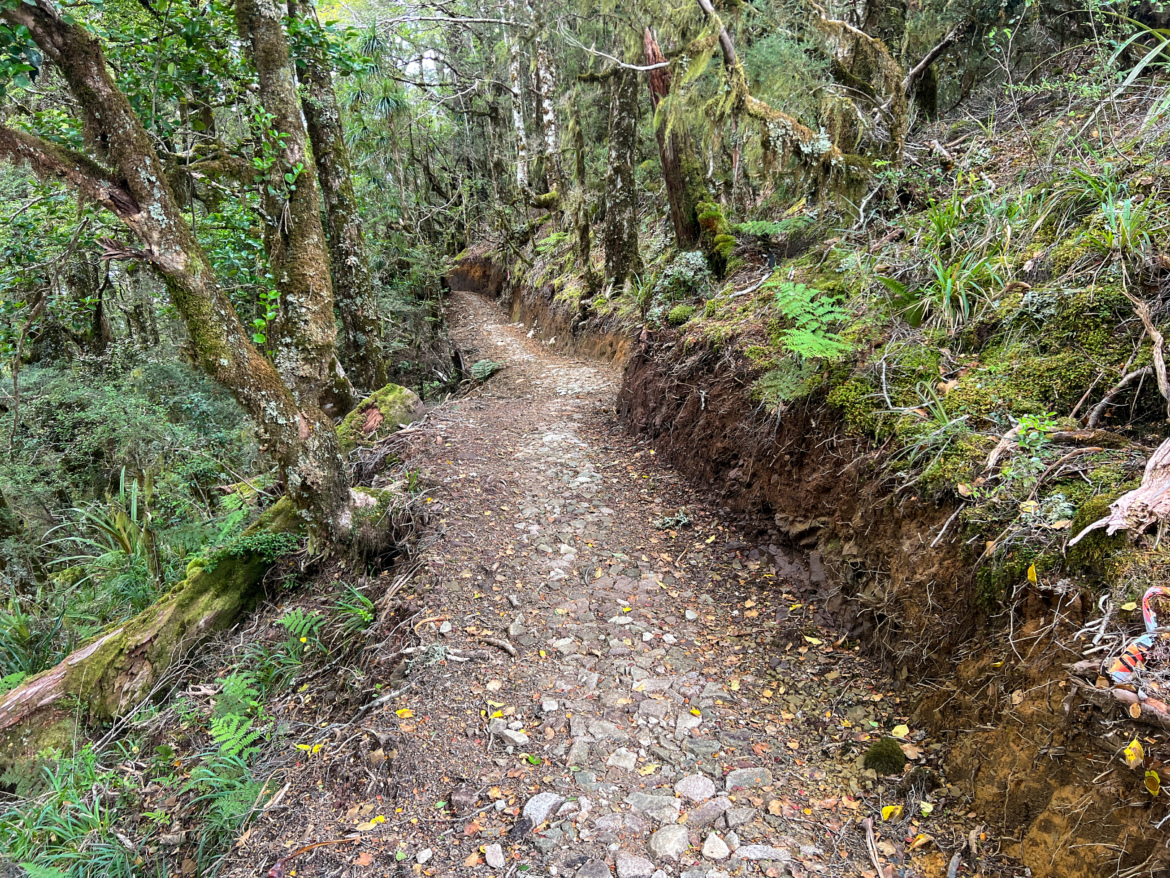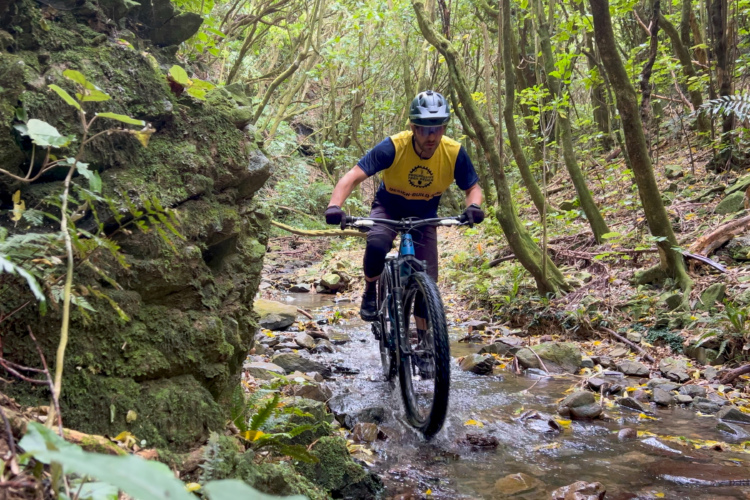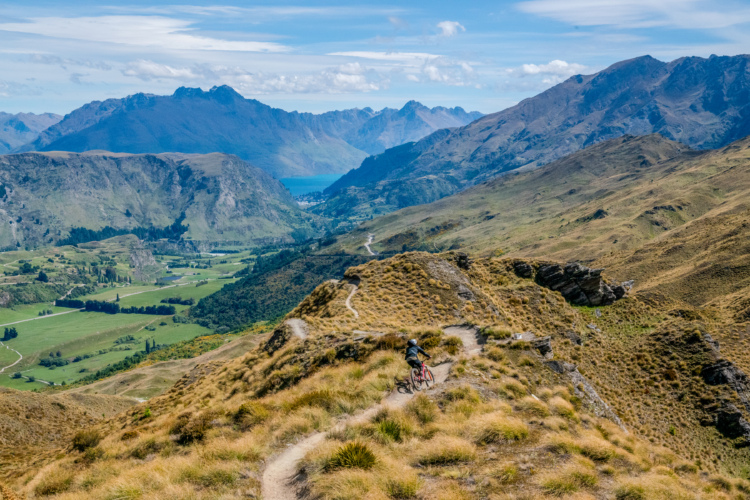
“We regret to advise you that the section of trail from Lyell Campground to Lyell Saddle hut is currently closed due to a large and unpassable slip,” read the email. “The section is closed until 11:59pm on the 10th of January 2025. The situation and repair work is dynamic and challenging and further updates will be provided as they become available.”
I was dumbstruck. I had flown to the other side of the planet largely to ride New Zealand’s Old Ghost Road (OGR), which many riders claim is one of the best mountain bike trails in the world. How was I going to overcome this challenge? I couldn’t let this entire trip be for naught, as I had no clue when I’d next be in New Zealand and have the chance to ride this famed long-distance backcountry trail.
Most mountain bikers pedal the OGR as a point-to-point route beginning at Lyell Campground and ending at the Rough and Tumble Lodge in Seddonville. The trail is designed to flow in that direction, with the route measuring just over 49 miles (79km) and notching 7,304 feet (2,226m) of climbing along its length, according to RideWithGPS. Ridden in this direction, the trail loses just a little more elevation than it gains — about 7,597 feet (2,315m). (Note: official sources claim the trail is 85km long, so your mileage may vary.)
I had planned to pedal the trail as a fairly relaxed 3-day, 2-night trip with my wife, Christine. The goal wasn’t to crush ourselves with big miles but to enjoy the beauty of being deep in the New Zealand backcountry, miles from the closest road.
The email went on to note that all the huts along the trail remained open and that we could either book a helicopter to bypass the landslide (called a “slip” in New Zealand) or access the trail from the northern end. Our ride was already going to be fairly relaxed, and shortening it an additional 11 miles via an expensive helicopter ride felt like it would cheapen the experience of backcountry immersion that we were after.
And so, we decided to do things the hard way by pedaling the Old Ghost Road as an out-and-back.




The Old Ghost Road: a brief history
Portions of what is now the Old Ghost Road were first built in the 1860s during the West Coast gold rush. At that time, a rugged mining road was built from the Lyell side and later, a road was built from the Seddonville side up the Mōkihinui River to access mine sites and areas that became small mining towns.
In 1929, the Murchison earthquake reshaped this landscape, destroying bridges and triggering numerous landslides that effectively shut down the roads, especially on the Seddonville side. As riders pedal the modern-day trail, they can learn more about the history of mining in the region and the earthquake damage through informational plaques. The damage was further exacerbated by the 1968 Inangahua earthquake.
According to Wikipedia, the Department of Conservation (DOC) devised a proposed “Lyell and Mōkihinui road, and when Marion Boatwright and Susan Cook, who had recently purchased land near Seddonville for a lodge, learned about it, their interest became piqued. They formed the Mōkihinui-Lyell Backcountry Trust in 2008.
The Trust went on to map and spearhead the building of a track connecting the historic mining roads near Lyell and Seddonville, with the goal of creating a tourist tramping route. Eventually, they completed the route in December 2015, and it is now a part of the New Zealand Cycle Trail. The Trust also constructed four iconic backcountry huts along the track, which they continue to manage, in addition to the Rough and Tumble Lodge.

Doing things the hard way: 76 miles on the Old Ghost Road
Based on our existing hut bookings, we added another night of lodging at the Specimen Point hut and decided to pedal the OGR as follows:
- Seddonville (northern trailhead) to Specimen Point Hut: 12.1 mi and 1,923ft of climbing, according to my Garmin
- Specimen Point to Ghost Lake Hut and trail high point: 29.54mi and 6,775ft of climbing
- Ghost Lake Hut to Specimen Point: 23.33mi and 2,051 ft of climbing
- Specimen Point to Seddonville: 11.26mi and 906ft of climbing
- Total recorded stats: 76.23 miles and 11,655 feet of climbing
With four high-quality Old Ghost Road huts positioned along the route plus two additional Department of Conservation huts, there are plenty of ways to break up the route to suit your desired challenge level. When ridden one-way, many riders choose to pedal the OGR as an overnight ride.
From the northern trailhead, the OGR begins in the lush coastal rainforest that covers the West Coast of New Zealand. After living for years in the arid Rocky Mountains of Colorado, pedaling for miles and miles through dense rainforest is a surreal experience! The native bush is unbelievably beautiful, with towering fern trees, gnarled vines, and New Zealand’s iconic bird life. Before invasive species were introduced, the only mammals that lived on land in New Zealand were a few species of bats. The rest of the island’s inhabitants were birds and reptiles — most of which aren’t found anywhere else in the world!
We pedaled along the rushing river, crossed vaulted suspension bridges, and enjoyed endless trailside waterfalls. The rainforest continued well into our second day of riding until we began to push higher up the mountain. The trees slowly changed, and eventually, we reached the high alpine terrain that the OGR is most famous for. The upper reaches of the trail break above the treeline, with a stunning traverse along Skyline Ridge before dropping back down, climbing again, and heading for the high point.

The highest section of the OGR is a stupendous traverse beneath the summit of Rocky Tor, which towers over the landscape at 4,776ft (1,456m) above sea level. While Christine and the other riders who coincidentally had the same itinerary all stopped at the Ghost Lake Lodge on our out-and-back route, I soldiered on to experience this surreal traverse and the breathtaking views from the high point of the trail, finally turning around and calling it a day nine and a half hours after we had left that morning. This second day of riding on the route proved to be an absolute beat down, with my most elevation gain of any ride in 2024 in just over half the distance of my longest ride of the year.
From Ghost Lake Hut, we simply had to reverse the direction and pedal out — but as you can see from the stats, it’s far from a mere downhill rip back out to the car!

Is the Old Ghost Road the best mountain bike trail in the world?
As I spent hours grinding up mountains, I had nothing better to do than ponder the question, “Is the Old Ghost Road the best mountain bike trail in the world?”
First, the idea of “best” needs to be qualified. While I heard rumors that the Old Ghost Road was a 50-mile “flow trail” through the backcountry, that proved not to be the case. Instead, it’s best to characterize the OGR as a bike-optimized backcountry trail. Comparing it to a high-quality front-country flow trail or, really, a front-country mountain bike trail of any kind is folly.
Rather, the OGR is a backcountry bikepacking-style experience (even if I did force my Pivot Switchblade to do double-duty on my New Zealand trip — ripping downhill bike parks with the full-face helmet and then turning around and loading it down with bike bags). In the bikepacking category, the OGR may be in a class of its own.
It’s rare to find 50 miles of uninterrupted bike-legal singletrack and even rarer to find 50 miles of singletrack that doesn’t cross a single gravel road. Even the famed Colorado Trail crosses numerous gravel roads during its most continuous bike-legal singletrack portions. But when you’re on the OGR, you are truly in the backcountry — there’s no bail-out options, no shortcuts. You’re fully committed.

Despite being so remote, the bike-optimized construction of the OGR and the lengths the Trust goes to keep this trail rideable by mountain bikes is impressive. After having just hiked one of New Zealand’s Great Walks through similar terrain — the Copland Track — I had a bar to judge the trail building against. The muddy, rocky, rugged West Coast terrain is brutally gnarly — the Copland Track would have been unrideable on a mountain bike. The OGR, in comparison, is being built and maintained to a grade 3 rating, which equates to a low intermediate difficulty in the USA. Currently, there are still some grade 4 sections on the trail (upper intermediate), but the Mōkihinui-Lyell Backcountry Trust is working to build smoother, easier trails through those sections.
The Trust actively reinvests funds generated by the huts and the lodge back into trail maintenance and trail building. During our ride, we passed a trail building camp and multiple machines out on the trail, fixing up sections that had washed out or otherwise been damaged by the constant deluge of rainfall. We didn’t see a single person working, but it’s highly likely that all staff had been picked up and relocated to fix the landslide on the southern end as quickly as possible — which we did not reach.




One piece of trail work we did spot was a brand-new reroute around the Skyline Steps, which used to be a heinous section of trail consisting of a literal staircase anchored to the mountainside. Now, a brand-new bike-optimized stretch of singletrack bypasses the staircase section, and according to locals we met, it may have opened within just the past couple of weeks. The effort that the trail builders took to dynamite a bench into sheer cliff faces was readily apparent and a testament to the continued investment in the OGR.
Many sections of the OGR trail tread were covered by gravel. In some places, this was likely the only way to soak up the mud enough to keep the trail rideable. However, some gravelly sections in the alpine were clearly the result of trail crews breaking the rocks apart into large-bore gravel bits and spreading this gravel along the trail. When ridden in the uphill direction, these deep gravel pits are virtually unrideable. Personally, I’d prefer to simply ride the bedrock instead of manufactured gravel, but that would put the trail past the intended grade 3 rating.

The huts put the backcountry experience over the top.
New Zealand is renowned for its DOC hut system, but the OGR huts take hut living to the next level. The mattress pads are at least twice as thick as those in standard DOC pads, and the huts are spacious, comfortable, and equipped with extra amenities — most notably, indoor cooking facilities and all of the pans, plates, bowls, and cutlery you’d need.
While staying in huts is common in Europe, and some hut-to-hut routes can even be found in the USA, it’s important to reiterate that all of the OGR huts have been built deep in the backcountry with no road access. All of the supplies to build the hut had been helicoptered in, so when you’re staying at a hut on the OGR, you’re fully immersed in the New Zealand backcountry. It’s truly remarkable and unlike anything you’ll find in North America or Europe.

The verdict
The combination of 50 miles of bike-optimized, regularly maintained singletrack, stunning scenery, and comfortable backcountry huts with no road access whatsoever means that, yes, the Old Ghost Road is hands-down one of the best backcountry singletrack mountain biking experiences on the planet. While you’ll need to adjust your expectations to include the challenges of some loose gravel, grinding climbs, and other challenges, the Old Ghost Road rewards riders who bring their adventurous spirits with the trip of a lifetime.

Logistics
Booking
You don’t need to pay a guide company thousands of dollars for a ride on the Old Ghost Road. It’s easy to book it yourself:
- Book your lodging with the Trust, here. A few different options exist, including private sleep outs and tent platforms. But to stay in the huts costs $160 NZD, regardless of how many nights you’re on the trail. Staying at the Rough and Tumble Lodge is extra.
- Book a car relocation. One of the easiest ways for travelers from out-of-country to complete the OGR is to rent a car and drive to the southern trailhead. Then, book a car relocation with one of the OGR’s recommended companies, and your car will be waiting for you when you arrive in Seddonville. This eliminates time spent sitting on a shuttle vehicle and makes for a seamless and affordable experience.
Travel
- Fly into Nelson. If traveling from out of the country, plan to fly into Nelson. To reach Nelson, you may need to switch airlines in one of the major New Zealand hubs like Auckland or Christchurch. Nelson is one of the closest airports and also home to incredible trails, making for a great addition to your trip.
- Rent a car in Nelson and drive to the Lyell Saddle OGR trailhead to begin the route as a point-to-point.
Packing List
Here’s a list of specific items you’ll need (or won’t need) if you’re staying in the huts. In addition, pack all items you’d normally bring for a bikepacking trip.
- Sleeping bag. The huts provide thick, vinyl-covered mats for the beds, but you’ll need your own sleeping bag. Note that it can get warm in the huts, especially during the summer, so a lightweight sleeping bag, or even a thick bag liner on its own, is a good choice.
- Water filter. The huts are supplied by rainwater from the roof. Some locals just drink the water as-is, but it is not guaranteed safe to drink. A water filter could also come in handy if you need to fill up during the middle of the day.
- Water bottle (1 or more). While you can opt to carry a hydration reservoir for your time on the bike, a water bottle comes in handy for drinking at the hut and packing an electrolyte mix in your bottle cage. It’s also easier to filter water into a bottle during the middle of the day if needed. I chose to pack two bottles and leave the reservoir at home.
- Food. Pack whatever food you’d normally bring for a bikepacking trip. However, if you want to get fancy, know that all the cookware you need will be provided at the huts, so you could choose to make more elaborate meals than what can be prepared over a backpacking stove.
- Rain gear. You’ll spend most of the trip riding in a coastal rainforest, so it’s a good idea to pack quality rain gear — not just a lightweight emergency jacket.
- Emergency TP. The OGR huts feature composting toilets that are fully stocked with toilet paper, but the DOC huts are likely not. So, you don’t need to bring a full TP roll, but packing a little extra is always a good idea.
- Clothes. Pack the same layering system that you’d bring on a normal bikepacking trip. I personally packed too many warm layers for our mid-summer trip, but I also used my down puffy jacket as a pillow, so it all worked out.
- Bike repair gear. Again, pack all the bike repair gear you’d normally bring on a bikepacking trip. While it appears that at one time some of the huts may have had bike pumps and basic tools, the ones I found were broken and/or missing parts. Plan to be self-sufficient for your bike repairs.
- Pack it in, pack it out. As luxurious as the huts may feel, there is no trash service. Like any backcountry trip, whatever you pack into the backcountry, you’ll need to pack out with you.




















1 Comments
46 minutes ago